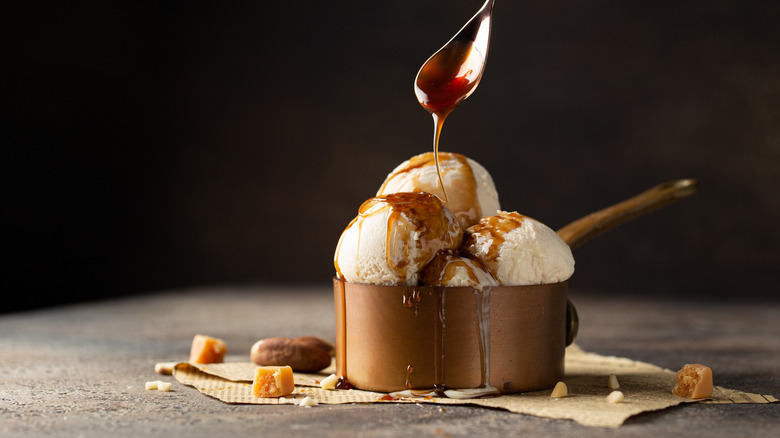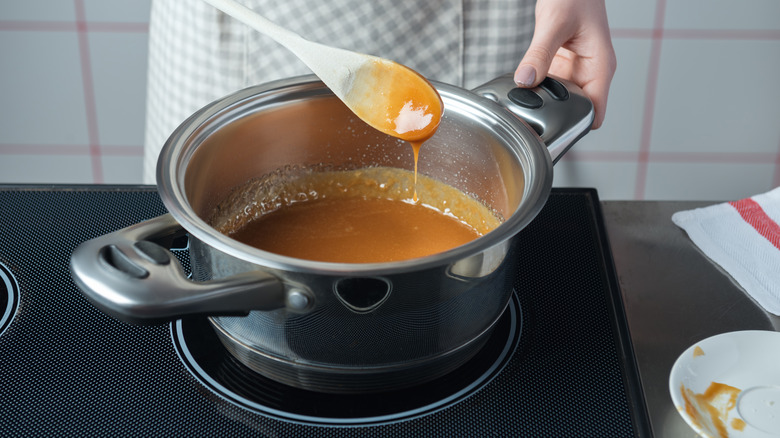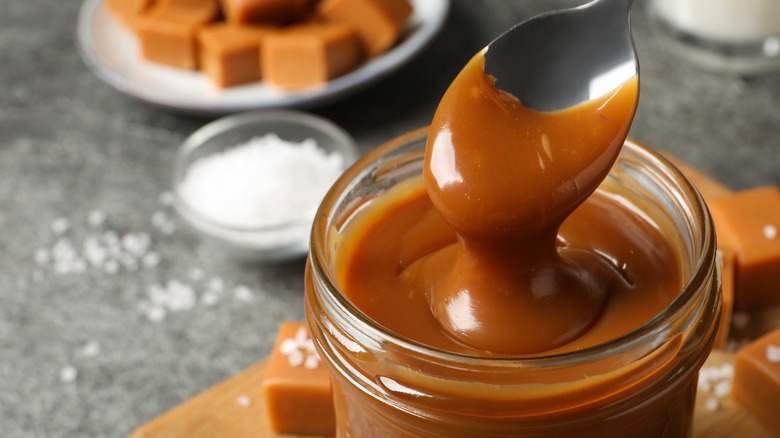What To Do When Your Caramel Sauce Turns Out Way Too Grainy
Caramel adds a rich, creamy textural delight and warm sweetness to an array of desserts, including vanilla ice cream, apple pie, and luscious salted caramel-filled chocolate cookies. If you've never made homemade caramel sauce, trust us when we say it's far better from the bottled stuff at the store. But the reward doesn't come without a precise method.
To master a basic caramel sauce recipe, first you must melt granulated sugar in a heavy-duty saucepan over medium-low heat and allow it to caramelize. You can achieve this using a dry cooking method, which involves melting sugar without any water, or the wet method, by adding just enough water to give the sugar an appearance of wet sand. Many bakers prefer the wet method because it makes burning the sugar less likely.
While burning sugar is often a fear for those who try their hand at caramel sauce, one of the other biggest frustrations home cooks encounter is that the sweet, sticky mixture turns grainy. This not only is visually unappealing, with clumps of sugar as opposed to being velvety and soft, but it also affects the taste and mouthfeel (think: chunky bites of crystallized sugar). Graininess occurs when the sugar in caramel sauce hasn't completely dissolved before adding in butter and heavy cream or if the caramel is cooled too quickly. Luckily, you can bring grainy caramel sauce back to a smooth, creamy consistency with an easy fix. Simply reheat it on the stovetop and add more liquid.
How to repair grainy caramel sauce
To bring grainy caramel sauce back to lusciously creamy life, stir in a few extra tablespoons of liquid to dissolve the sugar completely and allow it to caramelize and develop in flavor. Depending on the recipe, the additional liquid can be added in the form of water, heavy cream, or non-dairy milk alternatives, such as soy milk, almond milk, or coconut milk. For an extra-rich addition, add extra butter instead, stirring it in until melted. Either way, what's important is introducing more moisture to the mixture as it heats to completely break down and dissolve the sugar molecules.
If you're still stuck with grainy caramel sauce after adding more liquid, another way to break down the sugar granules is to purée caramel sauce in a blender or food processor. While this works in a pinch, we prefer the reheating method. When you introduce more liquid, the sugar will have the chance to break down, cook, and develop its fruity, nutty, and brown flavors characteristic of the perfect caramel sauce.
Tips for making smooth, creamy caramel
To make a velvety, sweet caramel sauce to be used to craft desserts such as decadent salted caramel chocolate pie, first caramelize the sugar until its granules dissolve completely. Once the sugar and water become melted and heated to a temperature of 350 degrees Fahrenheit, the mixture should be a liquid consistency and an amber, golden-brown color. (Your kitchen will also begin to develop a deliciously sweet, aromatic fragrance.)
During the sugar caramelization stage, some bakers add a tablespoon of liquid corn syrup or honey, which helps fully melt and meld the sugar and prevents crystallization in the first place. It can also help to add acidic ingredients, such as lemon juice, cream of tartar, or vinegar, to prevent graininess. But use caution, as acid may impact the flavor. When making caramel sauce, it's also important not to over-agitate the sugar as it caramelizes. Let it sit as it melts, or simply swirl the mixture gently using a wooden spoon or silicone spatula.
Once the sugar has melted and fully dissolved into a golden liquid, you'll be ready to add heavy cream and butter to incorporate, allowing the mixture to bubble and boil for just a minute before removing the saucepan from heat. Then, mix in salt and any flavorings, such as vanilla extract, and allow the caramel to cool and thicken.


